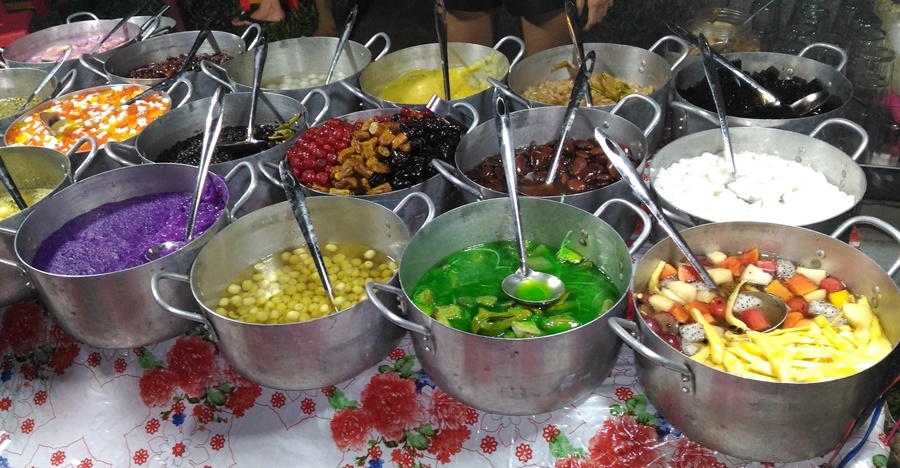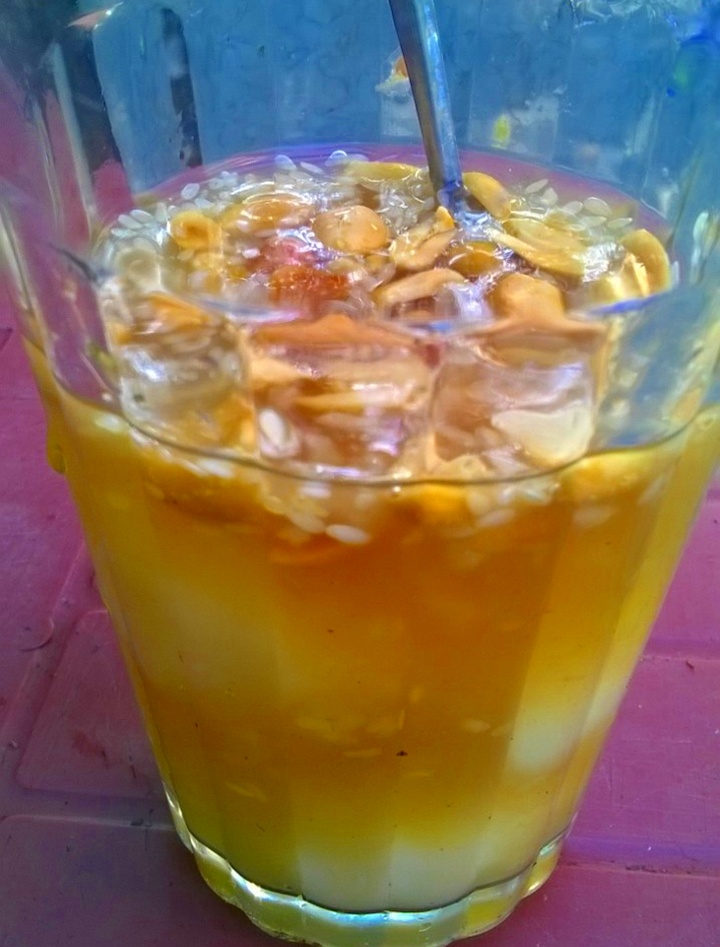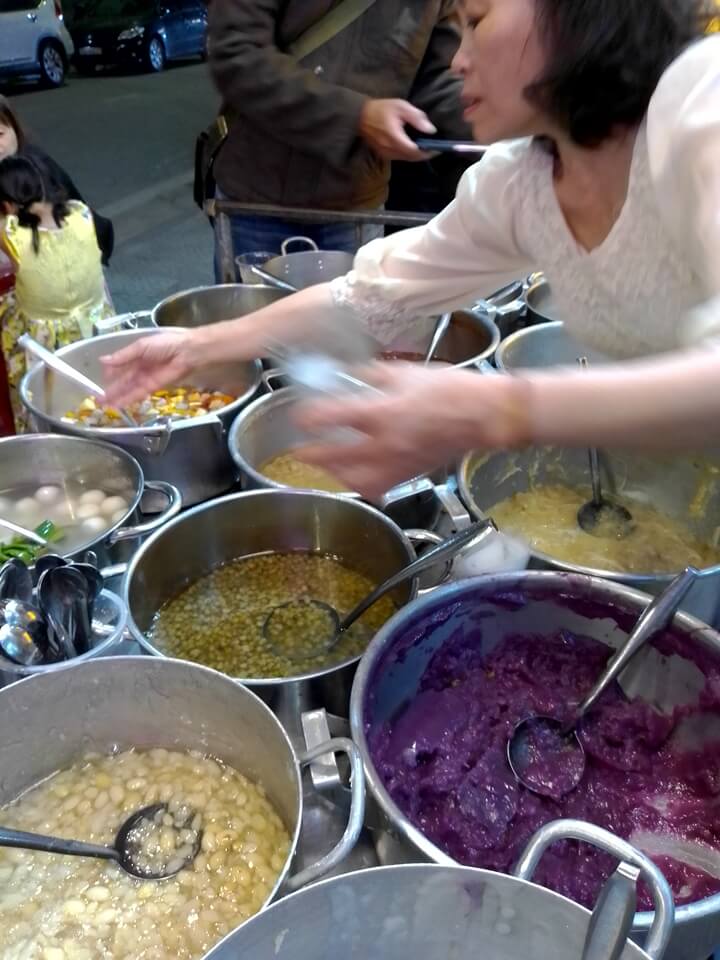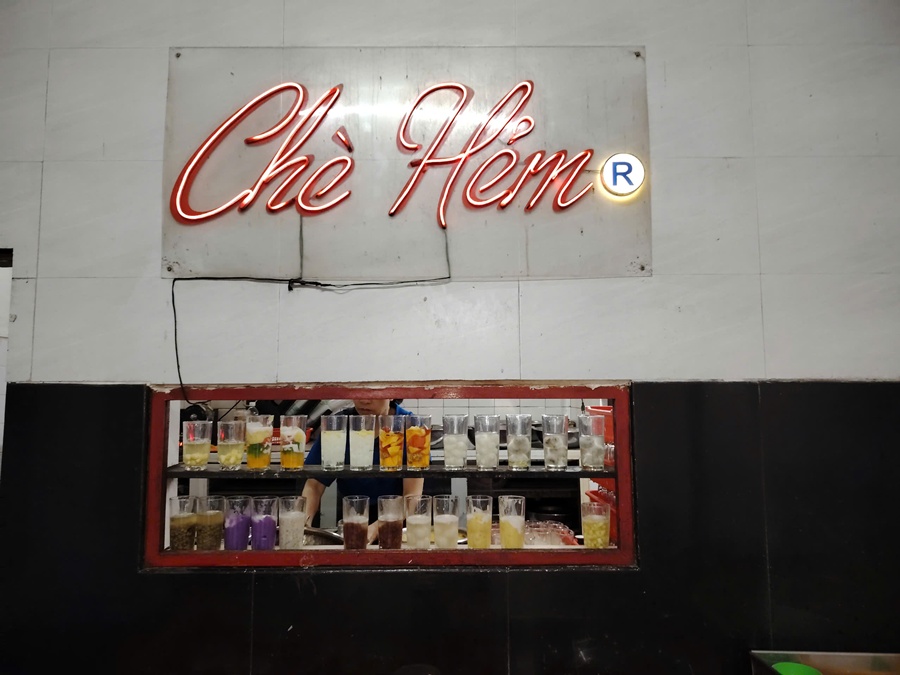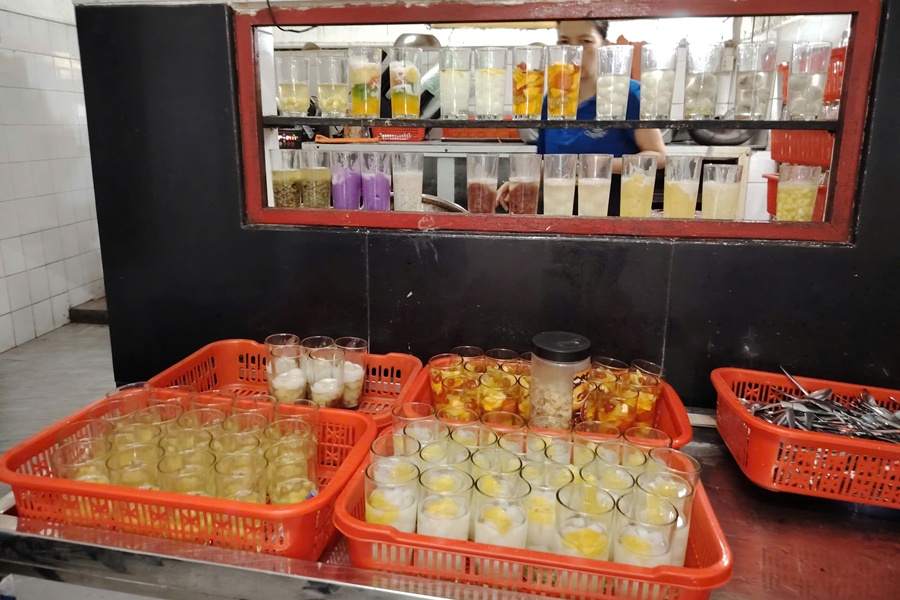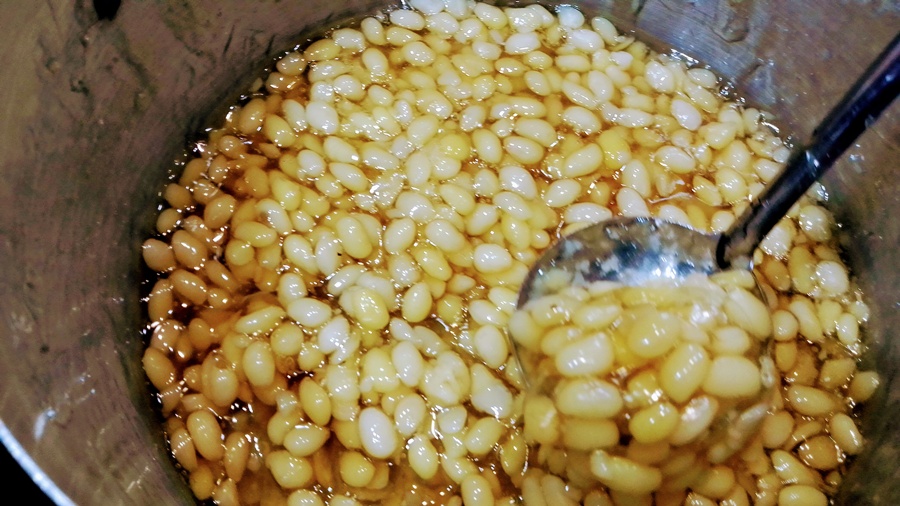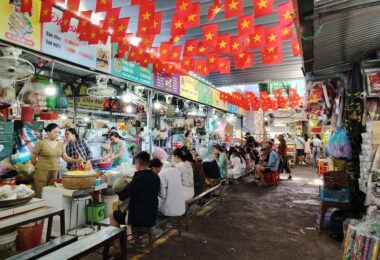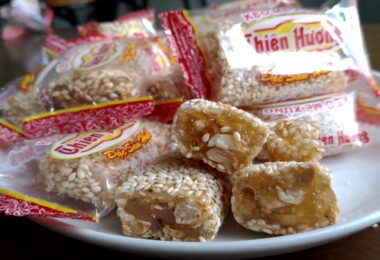Hue sweet soup, called Chè Huế, is a popular snack in Hue City, Vietnam. Chefs skillfully combine beans, fruits, tubers, and tapioca flour with sugar water to create a dish all ages love.
The sweetness of sugar, the mild aroma of pandan leaves, the richness of soft-cooked beans, and the vibrant colors have created the refreshing and irresistible charm of this typical dessert.
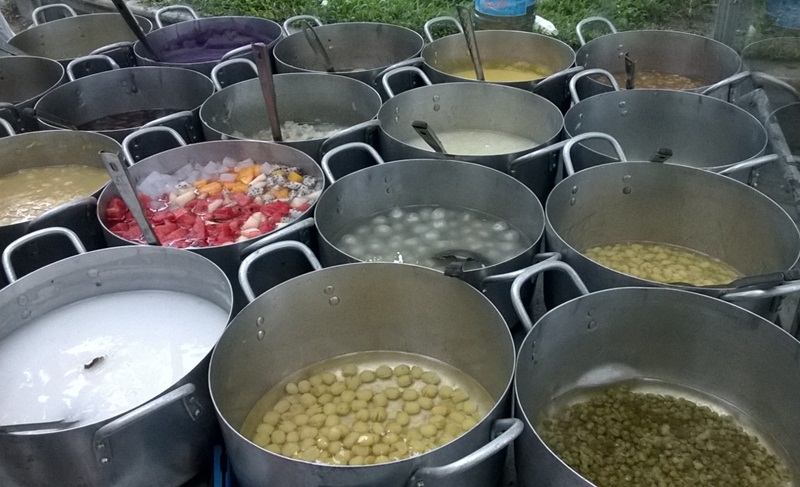
1. Various Types of Hue Sweet Soup
Hue is famous for its rich cuisine, and its sweet soup is a clear testament to that ingenuity and sophistication. Locals have transformed familiar ingredients into countless nutritious and colorful sweet soups.
The main ingredients are often various types of beans (such as mung beans, kidney beans, red beans, and broad beans), tubers (taro, sweet potatoes, and fat purple yam), various fruits, and tapioca flour. All are cooked with sugar water, creating a harmonious connection of flavors and textures.
Here are different types of Hue sweet soups, listed in both Vietnamese and English, to make it easier for you to order.
1.1. Typical and famous sweet soups:
- Chè hạt sen (Lotus seed sweet soup): An elegant sweet soup, considered a specialty of Hue, typically uses lotus seeds from Tinh Tam Lake for a softer and more fragrant result.
- Chè long nhan (Sweet soup of longan stuffed lotus seed): A delicate combination of the light sweetness of fresh longan and the richness of lotus seeds.
- Chè bột lọc heo quay (Cassava flour stuffed roast pork): A unique sweet and savory dessert, surprising but extremely tasty.
- Chè khoai môn vàng (Yellow taro sweet soup): Fragrant, smooth, and chewy from the specialty taro.
1.2. Traditional bean and root desserts:
- Chè đậu xanh (Mung bean sweet soup)
- Chè đạu đỏ (Red bean sweet soup)
- Chè đậu ngự (Huge bean sweet soup)
- Chè bắp (Corn sweet soup): Mildly sweet, fragrant with the smell of young corn
- Chè bông cau (Ground skinless mung beans): Unique with the shape of an areca flower, soft and smooth
1.3. Flour and fruit desserts:
- Chè hạt lựu (Sweet soup of sticky rice with pomegranate seeds): Small, chewy balls of rice flour like pomegranate seeds.
- Chè trôi nước (Sticky rice cake and mung bean): Fragrant sticky rice balls with a rich mung bean filling.
- Chè bột lọc dừa (Purified cassava with coconut): Clear, chewy balls of tapioca flour combined with rich coconut milk.
- Chè chuối (Banana sweet soup): Sweet and fragrant bananas with small tapioca balls.
1.4. Mixed sweet soup:
- Chè thập cẩm (Mixed sweet soup): This is the ideal choice to enjoy many flavors of sweet soup at the same time in one cup.
- Chè trái cây (Mixed fruit sweet soup): Different types of seasonal fruits are cooked together, and popular fruits include jackfruit, watermelon, sapodilla, and papaya.
1.5. Herb sweet soup:
- Chè dưỡng nhan (Herb sweet soup): Cooked from various traditional herbs with sugar for better health.
Whether you want to quench your thirst on hot days or warm your stomach in cold weather, Hue sweet soup is always the perfect choice. Don’t forget to try unique Chè Huế, such as roasted pork sweet soup, to experience the unlimited creativity of the local cuisine!
2. Ways to Eat Hue Sweet Soup
The diners often enhance the flavor of Hue sweet soup by adding coconut milk, peanuts, or crispy coconut jam.
Eating cold by adding ice: This is a good option for hot days. Diners add small pieces of ice to the glass, mix them with a teaspoon, and taste them, eating and drinking at the same time.
Eating warmly without ice: Use a tablespoon and try bite by bite. This method tastes much sweeter than cold eating, so it is often not ideal for less-sweet diners.
3. The Time When People in Hue City Often Eat Sweet Soup
3.1. Which month?
Although this dish is more popular in the hot summer, many types of Hue sweet soup are sold during the wet seasons, meaning you may find this sugary dessert all year round.
During hot days, many locals like to taste bean sweet soup (various types of beans), fruit sweet soup, and lotus seed dishes.
In cold months, many people enjoy various sweet soups, such as hyacinth bean with tapioca flour, tapioca and coconut sweet soup, and banana sweet soup.
3.2. Which time of day?
The locals eat sweet soup from mid-morning during summer or lunch during cold months until late at night.
They never eat them during breakfast because mornings are preferred for savory foods more than sweets.
This eating habit makes almost all shops selling this dish open late to serve diners. It’s too hard to find a shop selling this street food that opens at 9 AM or earlier.
4. Places to Taste Sweet Soups in Hue City
Hue City has tens of places to sell this sweet soup.
The most famous sweet soup shops that we tasted include:
- Chè Hẻm (Alley Sweet Soup Shop): 1/Alley 29 Hung Vuong Street, Hue City; opening from 10 AM – 8 PM
- Chè Hiền (Ms. Hien Sweet Soup Shop): 65 Tran Hung Dao Street, Hue City; opening from 2 PM – 10 PM at the yard of the theater
- Chè Cầm (Cam Sweet Soup Shop): 10 Nguyen Sinh Cung Street, Hue City; Opening from 4 PM – 10 PM
You may find many sweet soup shops in Dong Ba Markets, Tay Loc Market, or out-of-town markets. However, Mr Thom recommends that international tourists taste them at the above shops, which are much better for cleanliness.
However, one thing I do not like about almost all sweet soup shops is the cleanliness of the metal spoons. The way they wash them makes me hesitant to try them.
To solve this issue, I often ask them to pack a takeaway cup to carry so I can use my own spoon or a one-time spoon available.
5. Typical Ways to Sell Hue Sweet Soup
The eye-catching display is the first need to attract customers to choose a dish to taste, called eating by eye, which is influenced by the royal style.
Almost all shops arrange colorful dishes with red, yellow, brown, and white ingredients available to serve in front of carts or selling sections.
Customers can point to the order for which type of Chè to taste. This skill is easy to sell to international tourists when speaking another language.
The main containers for Chè Huế to serve are tall glasses or plastic cups. The sellers can put them in plastic bags for taking away or in ceramic dishes when eating without ice.
6. The Dedicated Skills in Cooking Hue Sweet Soup
Cooking Hue sweet soup has become a culinary art requiring meticulousness, dexterity, and family secrets from the ancient capital’s chefs. Each type of sweet soup is a colorful snack dish and a work of art, demonstrating a deep understanding of ingredients and flavors.
A typical example is Chè Heo Quay (Sweet soup of grilled pork and tapioca), a symbol of unique creativity. Small pieces of roasted meat are wrapped in soft, chewy tapioca flour and then dropped into clear sugar water. The pork’s savory flavor and sweet sugar syrup create a surprising and unforgettable taste experience, making diners unforgettable.
Or, like the sweet soups of lotus seed and lotus seed wrapped in longan, which are considered noble desserts often reserved for kings. The combination of soft, cool lotus seeds and the sugary, juicy taste of fresh longan creates a sophisticated symphony of flavors.
Corn sweet soup, made from typical young corn of Cồn Hến (Clam Island), conquers diners with its natural, pure sweetness and rustic aroma.
When you want to enjoy various flavors at the same time, mixed sweet soup is the perfect choice. Each glass is a skillful combination of many different types of sweet soup, a little bit of each, creating a colorful and harmonious whole and bringing a rich experience to the taste buds.
7. FAQs About the Sweet Soup
7.1. How much is a glass of sweet soup in Hue City?
The price is affordable for most people, from 10,000 VND to 20,000 VND per glass, depending on the shop and ingredients.
Meanwhile, small plastic bags with a 2-3 finger size at the local markets get a retail price of 5,000 VND to 7,000 VND, a childhood gift for kids when a mom returns from the market.
7.2. What is special about Chè Huế that cannot be found elsewhere?
Chè Huế differs from other places because it has complex cooking methods, from choosing ingredients to combining them. Some dishes used to be made in the royal court style, which is unique to this place, for example, Chè bột lọc heo quay, chè hạt sen long nhãn, and chè dưỡng nhan.
The second difference is that it has a variety of dishes. Usually, a sweet soup stall will have at least 10 different dishes, up to 20 different ones, creating diversity in types, colors, and flavors, meeting the diverse tastes of all diners.
7.3. Is Chè Huế clean?
According to Vietnamese rules, all foods must be clean and safe to be sold. However, sometimes, sellers cannot control the situation.
Thus, although the locals are comfortable tasting this food, I recommend that you, as an international tourist, think twice before tasting it.
If you are trying it, please choose popular shops rather than eating on pavements and local markets.
Typically, ice for sweet soups is almost made from regular tap water, which is a big deal for international travelers.
7.4. Is Hue sweet soup good for health?
Hue sweet soup has rich nutrients when made with plenty of beans and fruits. However, it uses sugar syrup, which is needed to accommodate a few people who do not like a sweet taste.
7.5. Can children eat sweet soup?
A child from 3 years old can eat some sweet soup, such as red bean sweet soup, hyacinth with tapioca sweet soup, and banana sweet soup.
The parents strongly need to pay attention to longan sweet soup, sticky rice ball sweet soup (chè trôi nước), grilled pork sweet soup, and coconut and tapioca sweet soup when children want to taste them. These dishes may block their throat from breathing when eaten incorrectly.
Although Hue sweet soup is a beloved local dessert, you won’t find it on our Hue Flavor Street Food Tour. Why? Our guide, Mr. Thom, has chosen to skip it due to concerns about cleanliness at some sweet shops. We’re committed to ensuring every tour stop meets high flavor and food safety standards.

